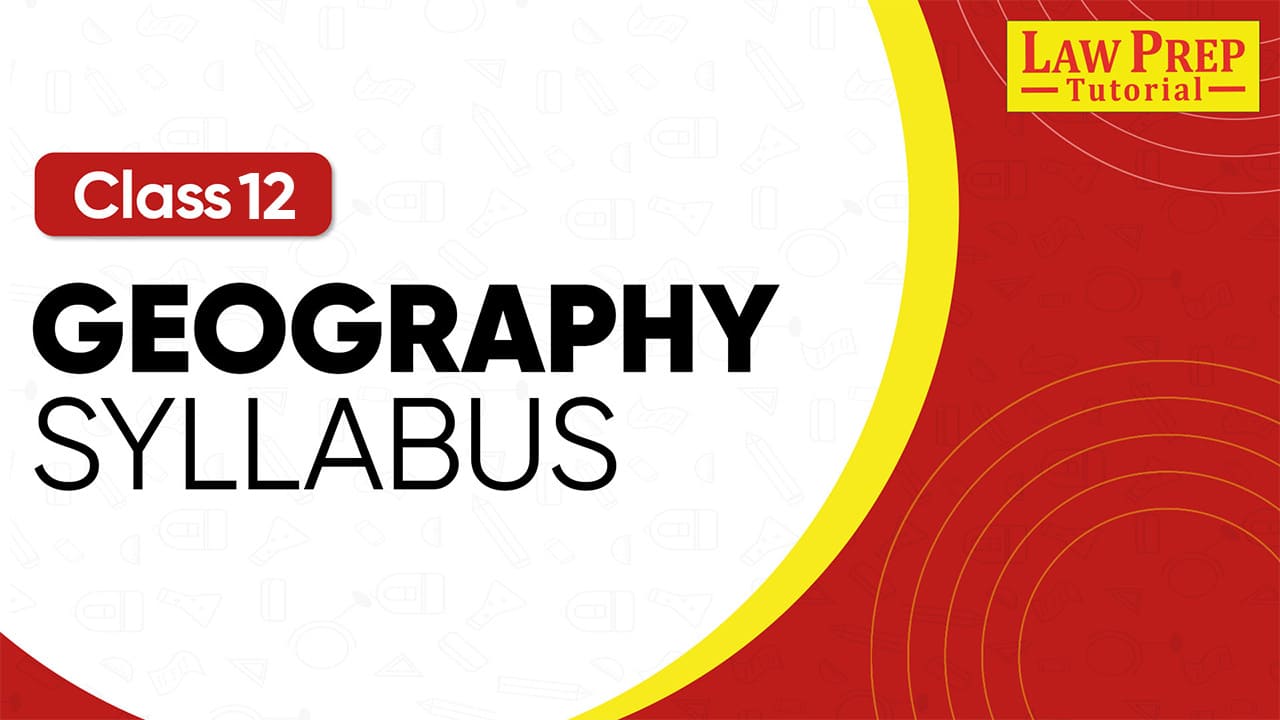Geography in Class 12 helps you understand the relationship between people and their environment, both at the global and national scale. The Class 12th Geography syllabus 2025-26 prescribed by CBSE is structured into three parts – Fundamentals of Human Geography, India: People and Economy, and Practical Work in Geography – Part II.
This syllabus not only deepens your knowledge of human and economic geography but also enhances analytical and practical skills through map work, data analysis, and field projects. It plays a vital role in board exams as well as competitive exams like CUET and UPSC.
Class 12th Geography Syllabus 2025-26: Overview
Find the overview of CBSE class 12th geography syllabus:
| Book | Units / Chapters | Weightage (Marks) |
| Book 1 – Fundamentals of Human Geography | Unit I: Human Geography (Ch-1) Unit II: People (Ch-2, 3) Unit III: Human Activities (Ch-4, 5, 6, 7, 8) Map Work: World Political Map | 35 |
| Book 2 – India: People and Economy | Unit I: People (Ch-1) Unit II: Human Settlements (Ch-2) Unit III: Resources and Development (Ch-3, 4, 5, 6) Unit IV: Transport, Communication & Trade (Ch-7, 8) Unit V: Issues & Problems (Ch-9) Map Work: India Political Map | 35 |
| Book 3 – Practical Work in Geography – Part II | Ch-1 Data: Its Source and Compilation Ch-2 Data Processing Ch-3 Graphical Representation of Data Ch-4 Spatial Information Technology Practical Record Book & Viva Voce | 30 |
| Total | 100 |
📥 Download Class 12 Geography Syllabus PDF
Download the complete CBSE Class 12 Geography Syllabus 2025-26 PDF and get the unit-wise breakdown, prescribed books, and exam pattern exactly as issued by CBSE.
Class 12th Geography Syllabus 2025-26: Book 1
Book 1 – Fundamentals of Human Geography
This book for the class 12 geography syllabus introduces the scope and nature of human geography and global patterns of population, human development, and economic activities. Students learn about agriculture, industries, services, transport, and international trade.
It helps them analyze how human activities are interlinked with physical environments and shape global economic and social interactions.
Unit I: Human Geography
The first unit of the class 12 geo syllabus defines human geography as the study of the relationship between humans and the environment. It explores approaches to human geography, from environmental determinism to possibilism, and introduces modern perspectives.
Students develop insights into how human societies adapt to and transform their surroundings.
| Chapter | Topics Covered |
| Chapter 1: Human Geography | • Nature and scope • Environmental determinism and possibilism • Perspectives in human geography |
Unit II: People
This unit of the class 12th geography syllabus deals with global population patterns, distribution, density, growth, and composition.
It also examines the concept of human development, highlighting indicators such as education, health, and income. Students analyze demographic changes and their implications for global development.
| Chapter | Topics Covered |
| Chapter 2: The World Population Density Distribution and Growth | • Population distribution factors • Density of population • Population growth trends |
| Chapter 3: Human Development | • Human development concept • HDI indicators • Global patterns of development |
Unit III: Human Activities
This unit in the syllabus of class 12th geography focuses on different economic activities carried out by humans across the globe. It covers primary, secondary, tertiary, and quaternary activities, as well as transport, communication, and international trade.
It explains how human efforts organize production, services, and exchanges that sustain economies worldwide.
| Chapter | Topics Covered |
| Chapter 4: Primary Activities | • Hunting, gathering, pastoralism, mining • Agriculture types and regions |
| Chapter 5: Secondary Activities | • Manufacturing industries • Industrial regions • Factors affecting location |
| Chapter 6: Tertiary and Quaternary Activities | • Trade, transport, communication • Services and IT industries • Knowledge-based industries |
| Chapter 7: Transport, Communication and Trade | • Transport modes (land, air, water) • Communication networks • Global trade patterns |
| Chapter 8: International Trade | • Importance of trade • Balance of trade • Globalization and trade blocs |
Map Work (World Political Map): Identification of features – 5 marks
More Important Resources for CBSE Exam:
| CBSE Board: All details | CBSE Class 11 Commerce Subjects |
| CBSE Full Form | All about CBSE Class 11th |
| Class 11th Hornbill Syllabus |
Class 12th Geography Syllabus 2025-26: Book 2
Book 2 – India: People and Economy
This book in the CBSE class 12th geography syllabus focuses on India’s human and economic geography. It examines population distribution, settlements, resources, agriculture, industries, water resources, planning, transport, and communication.
It also includes India’s international trade and geographical perspectives on issues like pollution, poverty, and migration. It builds a deeper understanding of India’s diverse economic activities.
Unit I: People
Introduces population distribution, density, growth, and composition in India. It highlights regional variations in demography and factors influencing population patterns. Students analyze census data and understand demographic challenges.
| Chapter | Topics Covered |
| Chapter 1: Population Distribution Density Growth and Composition | • India’s population growth • Population distribution and density • Demographic composition |
Unit II: Human Settlements
Covers the types and patterns of rural and urban settlements in India. Students study distribution of settlements, historical growth of towns, and modern urbanization trends. It highlights planning and challenges of urban settlements.
| Chapter | Topics Covered |
| Chapter 2: Human Settlements | • Rural and urban settlements • Urbanization trends • Problems of urban settlements |
Unit III: Resources and Development
Explains the significance of India’s resources—land, water, minerals, and energy. It also covers agriculture and planning for sustainable development. Students learn resource management strategies and understand environmental sustainability.
| Chapter | Topics Covered |
| Chapter 3: Land Resources and Agriculture | • Land use patterns • Agricultural types and crops • Problems of agriculture |
| Chapter 4: Water Resources | • Irrigation systems • Multipurpose river valley projects • Water scarcity issues |
| Chapter 5: Mineral and Energy Resources | • Distribution of minerals • Coal, petroleum, natural gas • Renewable energy |
| Chapter 6: Planning and Sustainable Development in Indian Context | • Planning goals • Five Year Plans • Case study on sustainable development |
Unit IV: Transport, Communication and Trade
Analyzes India’s transport networks—roadways, railways, waterways, and airways. Covers communication networks and India’s trade relations at national and international levels.
| Chapter | Topics Covered |
| Chapter 7: Transport and Communication | • Transport modes • Communication systems • Role in economic integration |
| Chapter 8: International Trade | • India’s trade patterns • Exports and imports • Role of trade in development |
Unit V: Geographical Perspective on Selected Issues and Problems
Focuses on major socio-economic and environmental issues of India such as pollution, poverty, slums, land degradation, and migration. Provides geographical perspectives on sustainable solutions.
| Chapter | Topics Covered |
| Chapter 9: Geographical Perspective on Selected Issues and Problems | • Environmental pollution • Poverty and slums • Land degradation • Migration |
Map Work (India Political Map): Location and labelling – 5 marks
Class 12th Geography Syllabus 2025-26: Book 3
Book 3 – Practical Work in Geography – Part II
The practical book in the CBSE class 12th geography syllabus strengthens data handling, statistical analysis, and use of technology in geography. Students learn data compilation, processing, and graphical representation using maps and diagrams.
It also introduces spatial information technology, helping students link traditional methods with modern GIS and remote sensing tools.
| Chapter | Topics Covered |
| Chapter 1: Data – Its Source and Compilation | • Sources of data • Census and surveys • Data tabulation and classification |
| Chapter 2: Data Processing | • Statistical methods • Averages, percentages • Data organization |
| Chapter 3: Graphical Representation of Data | • Bar diagrams, histograms • Pie charts, line graphs • Thematic maps |
| Chapter 4: Spatial Information Technology | • Remote sensing • GIS basics • Applications in geography |
| Practical Record Book and Viva Voce | • Maintaining record file • Viva voce evaluation |
Total Marks (Practical): 30
Class 12 Geography Syllabus: Question Paper Design
Marks Distribution:
| Part / Book | Marks |
| Book 1 – Fundamentals of Human Geography | 35 |
| Book 2 – India: People and Economy | 35 |
| Book 3 – Practical Work in Geography – Part II | 30 |
| Total | 100 |
Theory Paper (70 Marks):
| Typology of Questions | Learning Outcomes | Marks | Weightage % |
| Remembering & Understanding | Recall facts, terms, concepts; explain and summarize ideas | 22 | 27–30% |
| Application | Use of concepts and skills in new situations; interpretation of maps/graphs | 18 | 22–25% |
| Analysis, Evaluation & Creation | Analyze data, evaluate patterns, draw conclusions, map-based interpretation | 20 | 25–28% |
| Map Work | World + India map identification and labelling | 10 | 12–15% |
| Total | – | 70 | 100% |
Practical Examination (30 Marks):
| Component | Marks |
| Lab Work (Exercises from Practical Book) | 15 |
| Data/Graph/Map-based Practical Test | 5 |
| Practical Record Book | 5 |
| Viva Voce | 5 |
| Total | 30 |
Objectives of Class 12 Geography Syllabus 2025-26
The CBSE Class 12 Geography syllabus aims to provide learners with an advanced understanding of human and economic geography at global and national levels. It builds on the Class 11 foundation and focuses on analytical, spatial, and practical skills. The key objectives are:
- Understanding Human-Environment Relationships: To study how humans adapt to and modify their environment through population growth, settlements, and economic activities.
- Analyzing Global and Indian Patterns: To interpret world and Indian trends in population, agriculture, industry, transport, communication, and trade.
- Developing Spatial and Analytical Skills: To enhance skills in map-reading, thematic mapping, data analysis, and interpretation using diagrams and statistics.
- Exploring India’s Economic Geography: To examine India’s resources, industries, trade relations, and geographical issues, linking them with sustainable development goals.
- Promoting Environmental Awareness: To develop awareness about environmental problems like pollution, land degradation, and resource scarcity, and to explore sustainable solutions.
- Strengthening Practical Competence: To apply statistical, cartographic, and spatial technologies (GIS/remote sensing) in solving geographical problems.
- Preparation for Higher Studies and Careers: To provide a foundation for higher education in geography, urban planning, environmental studies, and competitive exams such as CUET, UPSC, and State PCS.
Check the latest CBSE Class 11 syllabus for all subjects below:
| Class 11th History Syllabus | Class 11th Chemistry Syllabus |
| Class 11th Legal Studies Syllabus | Class 11th Biology Syllabus |
| Class 11th Accountancy Syllabus | Class 11th Psychology Syllabus |
| Class 11th Entrepreneurship Syllabus | Class 11th Fine Arts Syllabus |
| Class 11th Business Studies Syllabus | Class 11th Sociology Syllabus |
| Class 11th Maths Syllabus | Class 11th Economics Syllabus |
| Class 11th Political Science Syllabus | Class 11th English Syllabus |
| Class 11th Physics Syllabus | Class 11th Hindi Syllabus |
| Class 11th Geography Syllabus | Class 11th Computer Science Syllabus |
| Class 11th Informatics Practices Syllabus | Class 11th Physical Education Syllabus |
| Class 11th Home Science Syllabus | Class 11th Sanskrit Syllabus |
Prescribed Books for Class 12 Geography Syllabus
- Fundamentals of Human Geography: Class XII, NCERT
- India: People and Economy: Class XII, NCERT
- Practical Work in Geography: Part II, Class XII, NCERT
Tips to Prepare for Class 12 Geography Syllabus 2025-26
Scoring well in Geography requires conceptual clarity, map practice, and strong presentation skills. Here are some practical tips to master the syllabus of Geography subject for Class 12th:
1. Study NCERT Books in Depth
The Class 12 Geography syllabus is fully based on NCERT. Read every chapter carefully, including tables, case studies, and examples.
2. Make Unit-Wise Notes
Prepare concise notes with headings, subheadings, and diagrams for each unit. This makes last-minute revision easier.
3. Practice World and India Map Work
Allocate regular time to practice map-based questions. Focus on agriculture regions, industries, mineral resources, transport routes, and trade centres.
4. Revise Diagrams and Graphs
Geography answers look better with diagrams. Practice population pyramids, climatic graphs, agricultural cycles, and flowcharts.
5. Master Practical Work
Don’t ignore Practical Work in Geography Part II. Practice data tabulation, statistical methods, and diagrams regularly to secure easy marks.
6. Solve Previous Year Papers
Attempt sample papers and past CBSE papers to understand the exam pattern, question trends, and map distribution.
7. Link Theory with Current Affairs
Relate concepts like international trade, population growth, or environmental issues with current news, making answers more relevant and analytical.
8. Time Management During Exam
Answer map questions first, then long answers, and finally short ones. This ensures neat and complete attempts.
Suggested Project Work for Class 12 Geography
Project work in Class 12 Geography gives students an opportunity to apply concepts from the syllabus of Geography subject for Class 12th to real-world issues. It builds analytical, research, and presentation skills, while also preparing them for higher studies and competitive exams.
- Analysis of population growth and migration trends in your local area.
- Comparative study of rural and urban settlements nearby.
- Case study on agricultural practices and crop diversification in your region.
- Survey of renewable energy usage and awareness in your city/town.
- Study of a local industry: location factors, workforce, and linkages.
- Report on urban transport problems and solutions in your city.
- Water resource management and conservation measures in your area.
- Field study on waste management and pollution control practices.
- Mapping international trade patterns of India’s major exports/imports.
- Research on socio-economic issues like poverty, slums, or migration in your locality.
Read the chapter-wise summaries of Class 11 English here:
FAQs About Class 12 Geography Syllabus
There are three NCERT books prescribed: Fundamentals of Human Geography, India: People and Economy, and Practical Work in Geography – Part II.
Class 12 Geography has 5 units in Fundamentals of Human Geography, 5 units in India: People and Economy, and 4 chapters in Practical Work in Geography – Part II.
There are 17 chapters in total – 8 in Fundamentals of Human Geography, 9 in India: People and Economy, plus 4 in the practical book.
The theory paper carries 70 marks, and the practical examination carries 30 marks. The theory exam includes MCQs, short and long questions, and map work.
Yes, map work is an essential part. World map work (industries, agriculture, trade) is from Fundamentals of Human Geography, while India map work (minerals, industries, agriculture, transport) is from India: People and Economy.
Important chapters include Population, Human Settlements, Land Resources and Agriculture, Mineral and Energy Resources, International Trade, and Geographical Issues and Problems.
It covers India’s population, settlements, resources (land, water, minerals), agriculture, industries, trade, transport, communication, and issues like poverty, slums, migration, and pollution.
Yes, Geography is a high-scoring subject because it combines theory with diagrams, maps, graphs, and practicals. With regular practice, students can secure excellent marks.
Yes, Class 12 Geography syllabus is helpful for CUET, UPSC, State PCS, and other competitive exams as it builds knowledge of human, economic, and Indian geography.
Yes, diagrams like population pyramids, trade flowcharts, agricultural cycles, and climatic graphs make answers clearer and fetch more marks.
Find detailed questions and answers from all chapters of English Class 11 now:
Discover CLAT exam resources that can help you get started early:
Explore CLAT coaching centers across different cities:


